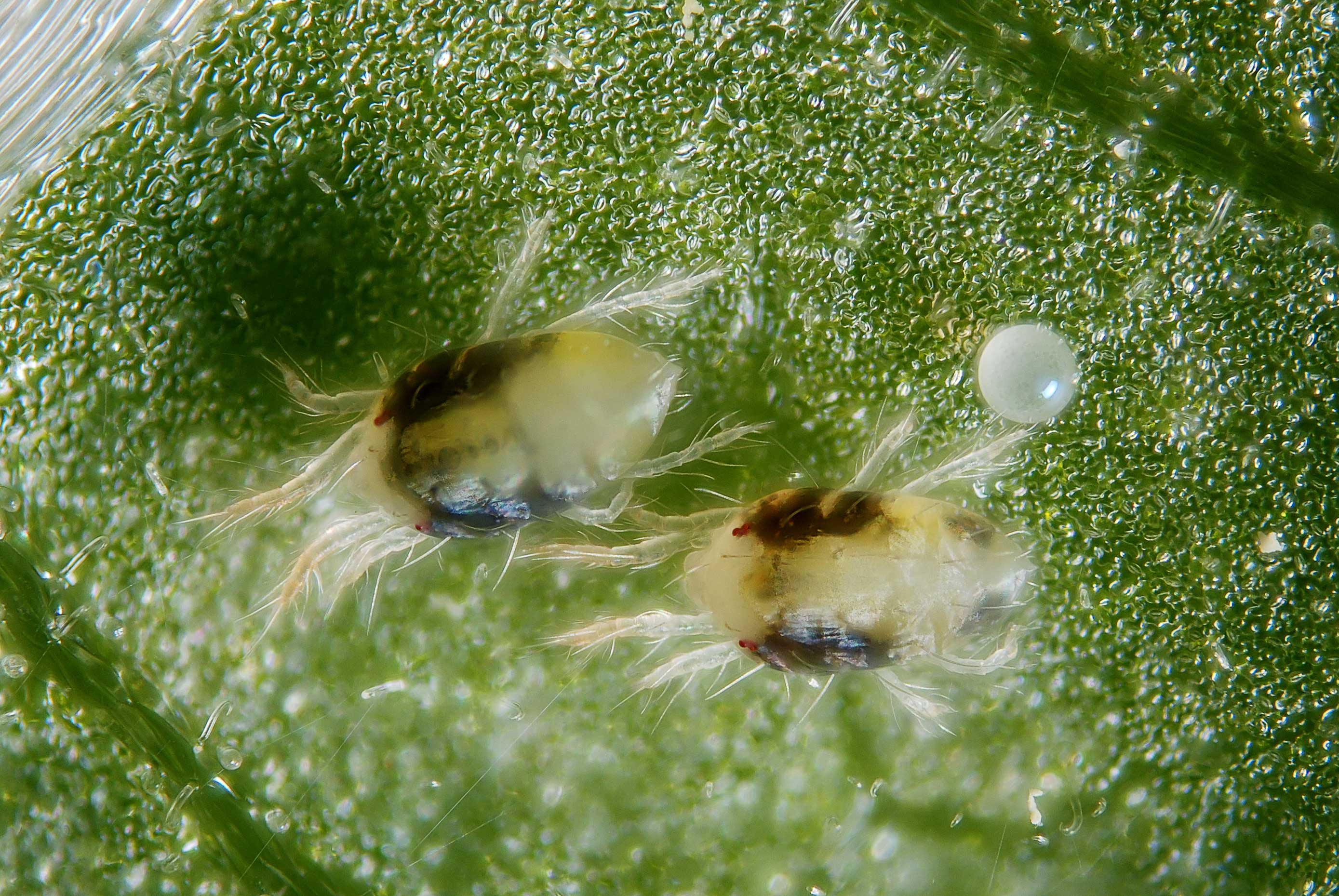2 Spot Spider Mite

This species has two dark spots, composed of food content, showing through the transparent body wall. The abdomen is oval and sparsely covered with spines. The adult male is smaller than the female and is characterized by its distinctly pointed abdomen. It sometimes has an orange or brown tinge and is usually more active than the female. The female is more robust than the male and is more oval in shape. Color of the female can vary; typically, it is a pale leaf-green, but it can also be tinged with yellow, brown, and sometimes orange.
The twospotted spider mite is an occasional pest on citrus, particularly in the San Joaquin Valley. Its damage potential varies from year to year and is related to water stress and heat. Monitor for twospotted spider mite year round and spray with the most selective miticide to preserve natural enemies. Since they’re so hard to spot, the best way to check for spider mite activity is to look for their distinct webbing and plant damage. If you notice plant foliage has small holes, and there’s webbing nearby, you likely have a spider mite infestation on your hands.

2 Spot Spider Mite
All stages of the twospotted spider mite overwinter in protected places on the tree, such as the navel of navel oranges, under the button, and where fruit touch. If the weather is mild, mites continue to feed and reproduce during winter. Activity increases in late spring and peaks in summer. Spider mites first appear on the underside of leaves and when numbers increase, they can also be found on the upper side of leaves and on fruit. They cover leaves and fruit with conspicuous webbing.
Eggs are spherical and translucent when first laid, becoming opaque before hatching. Immature mites molt three times before becoming adults; under ideal conditions, a generation can be completed in 7 days.
You can grow a surprising amount of food in your own yard. Ask me how!
~ Kate
Index
All
Artichokes
Asparagus
Beans
Beets
Beneficial Insects
Berries
Bok Choy
Broccoli
Brussels Sprouts
Bulbs
Cabbage
Carrots
Cauliflower
Celeriac
Celery
Chayote
Chickens
Chickpeas
Children's Activities
Collards
Compost & Mulch
Container Gardening
Corn
Cover Crops
Cucamelons
Cucumbers
Currants
Design
Eggplant
Endives
Fennel
Fenugreek
Flowers
Fruit & Nut Trees
Garden Design
Garlic
Grain
Grapes
Groundcherry
Guava
Herbs
Hops
Horseradish
Irrigation
Jerusalem Artichokes
Kale
Kiwifruit
Kohlrabi
Lawns
Lettuce
Melons
Mint
Native-plants
Onions
Parsley
Parsnips
Peanuts
Peas
Peppers
Pests & Diseases
Pineapples
Plant Care
Plants 101
Potatoes
Pruning
Pumpkins
Quarantine
Raised Bed Gardening
Rhubarb
Shade Gardening
Soil
Sorghum
Spinach
Squash
Strawberries
Succulents
Sunburn
Sunflowers
Sweet-potatoes
Tomatillos
Tomatoes
Turnips
Vines
Weeds
Wheat
Zucchini
2 Spotted Spider Mite Damage
RSS Feed
2 Spotted Spider Mite Life Cycle
Archives
Two Spotted Spider Mite Control
January 2021
December 2020
November 2020
October 2020
September 2020
July 2020
April 2020
February 2020
January 2020
December 2019
November 2019
October 2019
September 2019
August 2019
July 2019
June 2019
May 2019
April 2019
March 2019
February 2019
January 2019
December 2018
November 2018
October 2018
September 2018
August 2018
July 2018
June 2018
May 2018
April 2018
March 2018
February 2018
January 2018
December 2017
November 2017
October 2017
September 2017
August 2017
July 2017
June 2017
May 2017
April 2017
March 2017
February 2017
January 2017
December 2016
November 2016
October 2016
September 2016
August 2016
July 2016
June 2016
May 2016
April 2016
March 2016
February 2016
January 2016
December 2015
November 2015
October 2015
August 2015
July 2015
June 2015
May 2015
March 2015
February 2015
January 2015